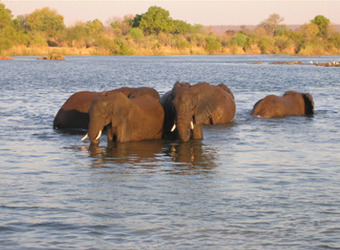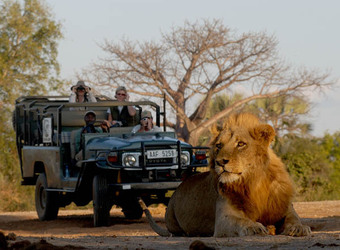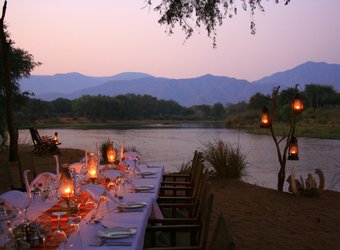Lower Zambezi N.P.
Click here to be the first to review Lower Zambezi N.P.
Start Planning Your Custom Safari view larger image
view larger image
Zambia’s newest national park, Lower Zambezi, is supreme wilderness, its quiet broken only by the cry of the fish eagle. The park’s lifeblood is the river coursing 90 miles along its eastern edge, drawing spectacular numbers of animals. Lying opposite is Mana Pools National Park in Zimbabwe, protecting an uninterrupted stretch of habitat for enormous herds of elephant and buffalo. Kudu and waterbuck hop between islands, while prolific lion and leopard lie in wait.
 view image gallery
view image gallery
The Safari Experience
The experiences are varied and plentiful here. Early morning and late afternoon wildlife drives set out by open, 4x4 safari vehicles into a wilderness sandwiched between a high escarpment and the mighty Zambezi River. Boats and canoes launch into the river, where you may view elephants bathing in the waters just ahead of you or towering over you from the banks, a truly contrasting experience to being on a wildlife drive or walk. Spot numerous hippo pods bobbing up and down through the surface of the water and crocodiles warming themselves on the riverbanks. Walks set out from camp, viewing the smaller details of the environment and sometimes encountering elephant, buffalo and even big cats! This is also one of the best places for catch-and-release fly or reel fishing, particularly for the famous tigerfish, an exciting catch for anglers of all abilities. Tigerfish are best in September through November.
 view image gallery
view image gallery
Wildlife
Wildlife is attracted to the floodplains, islands and lagoons along the permanent river. Approximately 50 mammal species persist in the park, including elephant, zebra, Cape buffalo, eland, roan, greater kudu, bushbuck, waterbuck, puku and many more. Much like in the Kafue, lions can be found up in the trees to escape the heat. Leopard, endangered wild dog, spotted hyena, side-striped jackal and honey badgers are some of the carnivores found in the park, and one might be very lucky to see a pangolin or a nocturnal aardvark or porcupine. With about 400 bird species, you will find most of the African favorites, with a pageant of kingfishers, heron, cranes, storks, rollers, and much more. Hippos sound their calls in the evening, and are almost always seen when boating or canoeing. Nile crocodile are very common as well. Elephant are often seen on the river banks or crossing to islands dotting the water, using their trunks like snorkels!
 view image gallery
view image gallery
How to Include the Lower Zambezi in Your Safari Itinerary
Recommended Number of Nights
Nature Travelers: 3 nights
Photographers: 3 nights
Families: 3 nights
Active Travelers: 3 nights
Other Regions to Include
Using Lusaka as a jumping-off point, the Lower Zambezi’s riverfront menagerie of wildlife can be easily enhanced by the South Luangwa’s famous walking safaris, adding Thornicroft’s giraffe and Cookson’s wildebeest to the list of mammals one might see. Further west, Kafue’s Busanga Plains offer a different landscape of open, grassy plains, where there is a great potential of seeing cheetah and large herds of buffalo and puku. Victoria Falls is a great place to start of finish your safari, showcasing the world’s largest waterfall. A contrasting experience awaits you in the Okavango Delta, where the land is a flat swath of waterways, flooding annually and teeming with wildlife. From Victoria Falls cross into Zimbabwe and visit Hwange National Park, where re-introduced rhino and impressive herds of elephant can be enjoyed. For a complete contrast, fly south to South Africa’s Southern Kalahari, featuring abundant black rhino, meerkats, Kalahari lion, giraffe and more in an endless vista.
